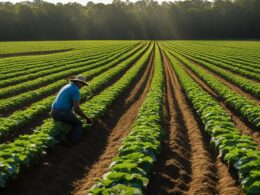The life cycle of a strawberry plant is a complex and fascinating process that spans the entire year. It starts with the germination of seeds or the propagation of runner plants and continues until senescence and death. The strawberry seed contains the genetic material necessary for the plant’s continuation, and upon sprouting, the roots grow downward into the soil while the plant transforms nutrients into plant matter.
Established strawberry plants also multiply themselves through the production of clone or daughter plants extended from the mother plant by means of stolons. Strawberry seeds usually sprout in late winter or spring, while runner plants are established in warmer temperatures from spring through fall. Once root growth begins, both seedlings and runner plants enter a phase of rapid growth, with the runner plants having the advantage of starting out larger and having a more fully formed support system.
After maturing, the strawberry plants are ready to multiply and expand using the runners to spread their range and find more favorable growth conditions. While the plants produce runners, they also devote significant energy to genetic diversification through seed production. The most common type of strawberry, the June-bearing strawberry, forms flower buds in late summer and early fall. These buds go into dormancy during winter and revive in late winter or early spring, turning into flowers that are pollinated by insects. Successful pollination leads to the development of achenes, which are seed-containing fruits.
The life span of a strawberry plant is typically 5-6 years, with productivity declining after 3 productive years.
Growth Stages of Strawberry Plants
The growth stages of a strawberry plant can be divided into several distinct phases. Understanding these stages is essential for successful cultivation and harvesting of strawberries.
-
Seedling Stage:
This is the initial stage where the plant sprouts from a seed and grows into a tiny seedling. It’s a slow growth phase as the plant establishes its roots and starts absorbing nutrients from the soil.
-
Cotyledon Stage:
During this stage, true leaves begin to form, indicating the plant’s healthy growth and progress. The cotyledon leaves provide energy and support for further development.
-
True Leaf Stage:
In this stage, the plant develops larger leaves and starts producing runners. Runners are long stems that have the potential to develop their own root system.
-
Runner Production Stage:
This is the final stage in the early growth phase of the strawberry plant. Runners extend from the main plant, allowing the formation of new strawberry plants. This stage contributes to the expansion and propagation of the strawberry plant.
These growth stages are vital to the early development and establishment of the strawberry plant. Each phase prepares the plant for subsequent stages of growth and reproductive success. Understanding the growth stages will help in providing the appropriate care and nurturing required for a fruitful harvest.
What Stage in the Life Cycle of a Strawberry Plant is Best for Transplanting?
When following a transplanting strawberries guide, the best stage in the life cycle of a strawberry plant for moving it to a new location is when the plant is dormant. This usually occurs in late fall or early spring, allowing the plant to establish itself before the growing season begins.
Reproductive and Maturation Stages of Strawberry Plants
After the early growth stages, the strawberry plant enters the reproductive stage, where it forms flowers and starts producing fruits. During this stage, bees and other pollinators help with the pollination process, leading to the development of small green berries that gradually turn into ripe, red strawberries. The reproductive stage is crucial for the plant’s propagation and the formation of a bountiful harvest.
Once the fruits have reached their peak size and ripeness, the strawberry plant enters the maturation stage. At this stage, the plant redirects its energy into ripening the existing berries rather than producing runners or flowers. The ripe strawberries are ready to be harvested and enjoyed, but it’s important to note that their shelf life is relatively short. The maturation stage marks the final phase of the strawberry plant’s life cycle.









